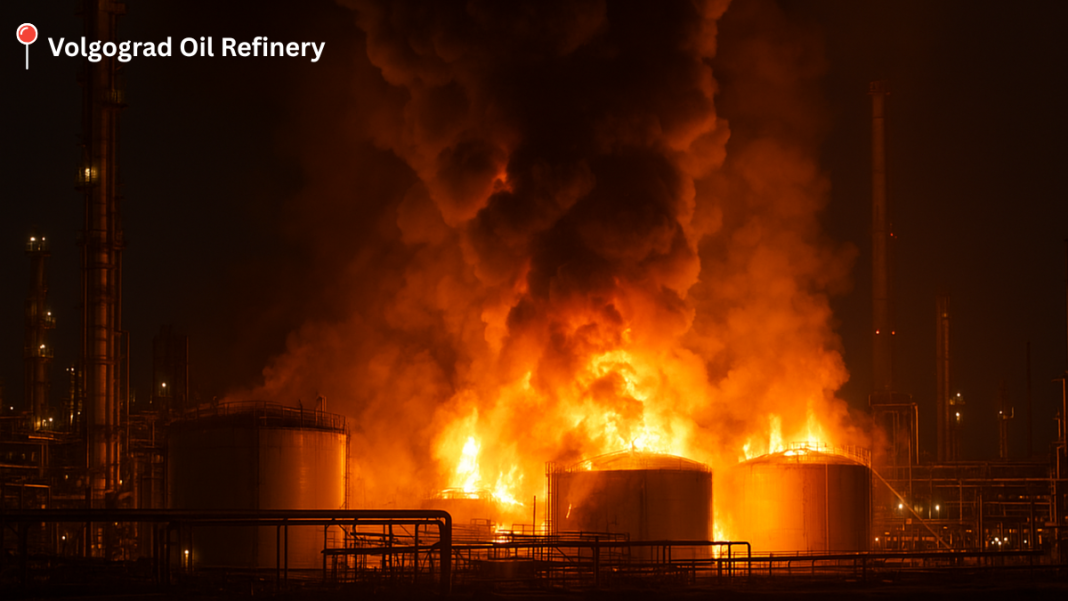The Russian city of Volgograd came under a major drone attack during the night of 13–14 August. The assault caused a series of explosions and started large fires at one of the most important industrial facilities in the region — the LUKOIL-Volgogradneftepererabotka oil refinery.
Large-Scale Night Attack on Volgograd
According to local reports, several unmanned aerial vehicles (UAVs) were involved in the strike. The noise of the blasts echoed across various districts of Volgograd, waking residents and causing panic in some neighbourhoods. Witnesses described seeing flashes in the night sky, followed by a loud roar and the glow of fires from the refinery area.
Officials confirmed that debris from downed drones fell onto refinery grounds, damaging structures and triggering fires. The impact also caused an oil spill inside the facility, which added to the danger and made firefighting efforts more challenging. Emergency response teams were quickly deployed to control the blaze and limit further damage.
🔥 Explosive Ukranian drone strike ignites massive fire at Saratov oil refinery in Russia
The attack forced the temporary closure of Volgograd’s local airport. The Russian Federal Air Transport Agency suspended all flights as a safety measure, with normal operations resuming only after the immediate threat had passed.
Key Target: Southern Russia’s Largest Oil Producer
The LUKOIL-Volgogradneftepererabotka refinery is one of the largest energy facilities in Russia’s Southern Federal District. It produces petroleum products for wide distribution and has an annual processing capacity of 14.8 million tonnes.
The site contains extensive storage tanks, refining units, and pipelines. Damage to any part of the complex can disrupt production and create serious hazards, including large-scale fires and environmental contamination. Oil spills are particularly dangerous because they can spread quickly and are difficult to clean up, especially in an industrial setting.
Ilsky Devastation: Ukraine’s Drone Strike Sparks Havoc at Russian Oil Refinery
The Volgograd refinery has faced multiple attacks over the past year. Drone strikes have targeted it repeatedly. Just one night before this latest strike — on 12–13 August — explosions shook the Krasnoarmeysky district, where the refinery operates.
In 2024, drones struck the facility twice — once on 3 February and again on 11 May — in similar assaults. Another significant incident took place on the night of 14–15 January, when an explosion at the refinery caused a fire that was visible from several kilometres away. These repeated incidents highlight the strategic importance of the Volgograd refinery in the ongoing conflict and its vulnerability to aerial attacks.
Pattern of Repeated Attacks in Volgograd
The most recent strike fits into a larger pattern of repeated assaults on industrial and fuel infrastructure in Volgograd and the surrounding region. Each attack has caused some level of disruption, whether by damaging equipment, igniting fires, or forcing temporary shutdowns.
Footage shared on local channels shows bright flames and thick black smoke rising high above the refinery complex. The glow from the burning fuel lit up the night sky, and the smoke could be seen drifting over parts of Volgograd hours after the attack.
The confirmed oil spill inside the refinery adds another layer of concern. Oil can seep into the soil and water systems, creating environmental problems that are expensive and time-consuming to address. Emergency teams worked to contain the spill and prevent it from spreading to nearby areas.
🔥 Precision attack engulfs Afipskiy refinery — Ukrainian drones torch Russia’s military fuel hub
Authorities in Volgograd quickly tightened security measures after the attack. They closed roads leading to the refinery to give emergency services full access to the site. Firefighting crews applied specialised foam and used equipment to tackle the burning oil, while other teams monitored air quality in the surrounding neighbourhoods.
Repeated drone strikes on the Volgograd refinery have defined the region’s security situation. Although officials have not fully disclosed the extent of the damage from the latest attack, the fact that drones have struck this facility several times within months shows its importance and the ongoing risks it faces.
